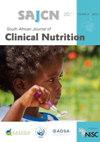在纳尔逊曼德拉湾,南非消费者的五个包装前标签的客观理解
IF 0.6
Q4 NUTRITION & DIETETICS
引用次数: 3
摘要
目的:本研究旨在评估南非纳尔逊曼德拉湾地区消费者对5种包装前标签格式的客观理解,即参考摄入量、多重红绿灯标签、营养评分、健康认可标志和警告标签。设计:这是一项横断面探索性研究。环境:访谈者管理的调查在城市环境中随机选择的12个食品零售店进行。对象:本研究共纳入359名成人受试者。结果测量:客观理解是通过要求参与者根据他们的营养质量对食品进行排名来测量的,使用展示在包装前面的标签。结果:包装前标签类型对排序能力有显著影响(p < 0.00001)。与没有标签的对照组相比,所有的评估性包装正面标签显著提高了参与者识别更健康食品的能力。然而,减少的参考摄入量对消费者的理解没有显着影响。结论:与参考摄入量和无标签对照相比,评估性包装正面标签显著提高了参与者识别更健康食品的能力。未来的研究应该测试对南非文化多样化群体的客观理解,特别是在农村人口中。本文章由计算机程序翻译,如有差异,请以英文原文为准。
Objective understanding of five front-of-pack labels among consumers in Nelson Mandela Bay, South Africa
Objective: This study aimed to assess the objective understanding of five front-of-pack label formats, namely the Reference Intake, Multiple Traffic Light label, Nutri-Score, health endorsement logo and warning label, among consumers in Nelson Mandela Bay, South Africa. Design: This was a cross-sectional, exploratory study. Setting: Interviewer-administered surveys were conducted at 12 randomly selected food retail outlets in an urban setting. Subjects: A total of 359 adult participants were included in this study. Outcome measures: Objective understanding was measured by asking participants to rank food products according to their nutritional quality, using the displayed front-of-pack label. Results: The type of front-of-pack label significantly influenced ranking ability (p < 0.00001). All the evaluative front-of-pack labels significantly improved the participants’ ability to identify healthier food products compared with the no-label control. The reductive Reference Intake, however, showed no significant impact on consumer understanding. Conclusion: Evaluative front-of-pack labels significantly improved the participants’ ability to identify healthier food products, when compared with the Reference Intake and no-label control. Future research should test the objective understanding of culturally diverse groups in South Africa, particularly among rural populations.
求助全文
通过发布文献求助,成功后即可免费获取论文全文。
去求助
来源期刊

South African Journal of Clinical Nutrition
NUTRITION & DIETETICS-
CiteScore
2.50
自引率
9.10%
发文量
21
期刊介绍:
1.The Journal accepts articles from all basic and applied areas of dietetics and human nutrition, including clinical nutrition, community nutrition, food science, food policy, food service management, nutrition policy and public health nutrition. 2.The Journal has a broad interpretation of the field of nutrition and recognizes that there are many factors that determine nutritional status and that need to be the subject of scientific investigation and reported in the Journal. 3.The Journal seeks to serve a broad readership and to provide information that will be useful to the scientific community, the academic community, government and non-government stakeholders in the nutrition field, policy makers and industry.
 求助内容:
求助内容: 应助结果提醒方式:
应助结果提醒方式:


